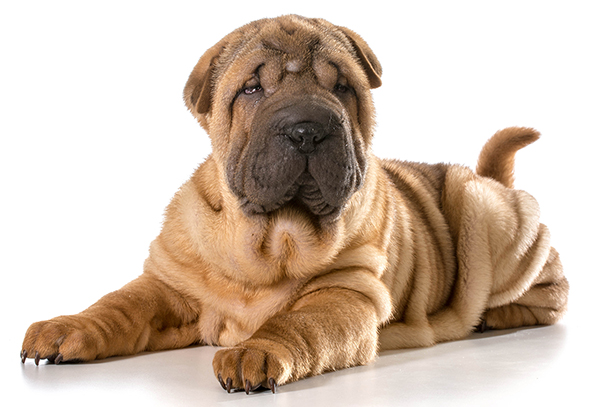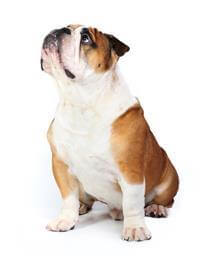
Shar Pei: breed overview
The Shar Pei originated in China over 200 years ago, and is a likely descendent of the ancient Chinese ‘Han Dog’ guard dog breed. The name Shar Pei means ‘sand skin’, which is down to their characteristically harsh, bristly coat and famously loose skin folds. Shar Peis were bred to be utility dogs used for herding and guarding property. This makes them intelligent and loyal dogs and they can be fierce or protective when faced with strangers or other pets. However, they are also known for their loving nature, and they can be affectionate and gentle with known family members.
- What makes Shar Pei unique?
- A Shar Pei grooming and hygiene needs
- A Shar Pei behaviour and training needs
- Do Shar Pei have a good temperament?
- Do Shar Pei bark a lot?
- A Shar Pei’s mental and physical stimulation
- Can Shar Pei be left alone?
- A Shar Pei’s nutritional requirements
- Do Shar Peis make good family pets?
- Shar Pei breeding and finding a responsible breeder
Thinking about adopting a Shar Pei? Check your local shelter first!
Every year many thousands of dogs are put up for adoption because their owners can’t cope with looking after them, or if their ideal dog didn’t turn out to behave as they expected. Shelters near you may have Shar Pei dogs looking for a loving home. Dog adoption can not only save you money and support a good cause but gives an adult dog or puppy another chance at a happy and fulfilling life.
Mixed breeds can offer the benefits of a Shar Pei’s loyal personality but with different characteristics. Popular cross breeds include the Shar-Poo (Poodle x Shar Pei) or a Golden Pei (Golden Retriever x Shar Pei). Cross breeds can often be found in dog shelters, so it’s worth keeping an open mind about your potential new pet’s appearance and size.
What makes Shar Pei unique?
Shar Pei dogs are medium-sized and are famous for their fiercely protective nature, making them suitable for experienced dog owners. Their appearance is striking, with a bristly coat, small triangular-shaped ears and loose skin folds which can make them look like they’re frowning - although the Shar Pei temperament is known to be loving and gentle with those who know them well. The Shar Pei lifespan is around 10 years.
Shar Peis are an ancient breed originating in China, bred as guard dogs and hunting dogs, and are known to be highly intelligent, devoted and independent. They are thought to be a relative of the Chow Chow, as they are both strongly protective and suspicious of strangers, and share the familiar blue-black tongue. Their famed wrinkled-looking skin is similar to that of the French Bulldog, Pug or Dogue de Bordeaux, and their loyal and sometimes fierce persona is like many of the other traditional guarding and sporting dog breeds.
Their coats come in a range of colours, from fawn to red, black, apricot and chocolate, or a mix of shades. Although Shar Peis are known for their short bristly hair, as seen in the Horse Coat and Brush Coat varieties, the Bear Coat has longer hair like its Chow Chow cousin. Pedigree Shar Pei dogs come in two common sizes:
- Standard Shar Pei - 46-51 cm in height - this may be a traditional Chinese Shar Pei purebred, or a Western Shar Pei dog, determined by their unique muzzle types and ancestry.
- Miniature Shar Pei - up to 43 cm in height - these dogs are bred for their smaller size and increased wrinkles.
A Shar Pei grooming and hygiene needs
The breed has a uniquely bristly coat with short fur, making dog grooming and maintenance relatively easy. It’s best to brush them once a week or so, to keep their coat healthy and knot-free, and bath them every so often, paying particular attention to gently cleansing the facial folds. Their skin folds can be at risk of developing dermatitis, so it’s important to keep these clean and dry to prevent skin getting sore. Your Shar Pei dog will also need their ears to be checked and cleaned regularly, as well as making sure you clean their teeth and keep their nails trimmed to help make sure your dog can walk and run comfortably.
A Shar Pei behaviour and training needs
Shar Pei have a fiercely loyal nature and are known for being affectionate to their owners, but they can sometimes be aggressive towards unknown people and other dogs due to their protective nature. When properly socialised though, Shar Pei temperament can be more predictable and docile with the right dog training techniques. These dogs are highly intelligent and usually learn very quickly. However, the breed are also known to be stubborn, so consistency is key. Owners may have more success by starting training at a young age - through positive reinforcement and patient practice, offering healthy adult dog treats, play and affection as a reward. A common trait of the breed is that they are wary of strangers, but socialising them from a young age, without becoming angry at the dog, helps to build your pet parent bond.
Do Shar Pei have a good temperament?
Shar Pei temperament is naturally assertive, protective and intelligent, but they can also be calm, loving and highly affectionate with those they know. The independent Shar Pei temperament makes them better suited to experienced dog owners and households with older children or adults, and as fast learners they’re considered easy and quick to train.
Do Shar Pei bark a lot?
Usually known for their confident demeanour, this breed are not known for excessive barking and many will be docile and calm. As guard dogs Shar Peis may become aggressive at new people or animals, but generally they’re not a noisy breed. Of course, this varies with each dog, their environment and their training.
A Shar Pei’s mental and physical stimulation
An important aspect of the famous Shar Pei temperament is intellect and strength, so it’s essential to keep your dog mentally stimulated as well as physically active. This breed needs a moderate level of exercise daily, with adults requiring up to an hour’s walk every day. Shar Pei dogs can get bored easily, so they will enjoy playing games as well as taking part in dog training and agility challenges.
As natural hunting dogs it’s common for them to chase other animals, so you may need to keep them on the lead until they’re sufficiently trained. If owners don’t give their Shar Pei enough exercise and mental stimulation, or if they are left alone for long periods, they can bark more and suffer from separation anxiety. It’s worth remembering that a Shar Pei lifespan is around 10 years, so you’ll need to make sure you can commit to keeping your dog active and mentally stimulated sufficiently every day, all year round.
Can Shar Pei be left alone?
Shar Peis don’t like being left alone for long, and many owners think that four hours is the maximum they should be left before they become agitated. They are loyal dogs who like to protect their own family, and thrive when around their usual people. Leaving them on their own can lead to separation anxiety and boredom, which negatively affects behaviour.
A Shar Pei’s nutritional requirements
An adult Shar Pei dog requires a high-quality complete dog food which is nutritionally balanced, to keep them healthy. The best diet for this strong, medium-sized breed is based on natural protein from top quality sources, and ideally animal protein such as chicken, beef, fish or lamb. Their feed should also contain the correct balance of carbohydrates, fats, vitamins, and minerals to keep their skin, coat, heart and digestive system in tip-top condition.
If you have a young dog, choose a specially designed puppy food, and as your dog gets older it can help to transition them to a senior dog food to support their needs. You can also supplement your dog’s diet with dog multivitamins, to support a healthy immune system, and which may help to prevent some of the skin complaints which are associated with the breed.
Do Shar Peis make good family pets?
Shar Peis can make protective and devoted family pets, but it’s essential to socialise and train them effectively so that their natural dislike of strangers doesn’t become problematic with other people and dogs. They do not usually make the best family dogs for households with young children, as they value their own independence and space. As hunters it’s in their nature to chase other animals, but with the proper training they can successfully live with cats and other pets once they’re used to them.
This breed can be compatible with smaller spaces, as they don’t require as much exercise as larger dogs, but they will need a safe area of their own and plenty of exercise outside every day. They also cannot be left alone for long periods, so are unsuitable for homes where adults are out all day. They are a highly protective dog, which is why they are often popular as guard dogs.
Shar Pei breeding and finding a responsible breeder
If you’re not adopting a pet from an animal rescue shelter, it’s imperative to buy your dog from a reputable dog breeder who promotes responsible breeding practices and conforms to ethical animal welfare standards. Finding a good dog breeder can take time, so do your homework and be prepared to join a waiting list. The Kennel Club has a list of registered breeders who conform to specific high standards.
Good dog breeders will make sure your puppy is socialised, vaccinated and in good health before you take them home. They should provide registration certificates and the correct papers detailing the mother and father and their history. A strong Shar Pei temperament means that high quality breeding is essential, to make sure the dogs aren’t nervous or aggressive. Look for a dog which is happy, sociable and healthy-looking. This breed are prone to eye and ear problems, so check that they eyes and ears look clear with no excess discharge.
Shar Pei owners love their unique-looking dogs who are full of character and are fiercely loyal. They make great pets for experienced owners and families with older children, and with good training they can make a docile, affectionate and loving pet who will enjoy being kept mentally and physically active by their pet parents. If you think a Shar Pei is the right dog for you, check out the adoption page to see if a dog or puppy near you is in need of a home, or browse the breed finder page to read more about other varieties.






